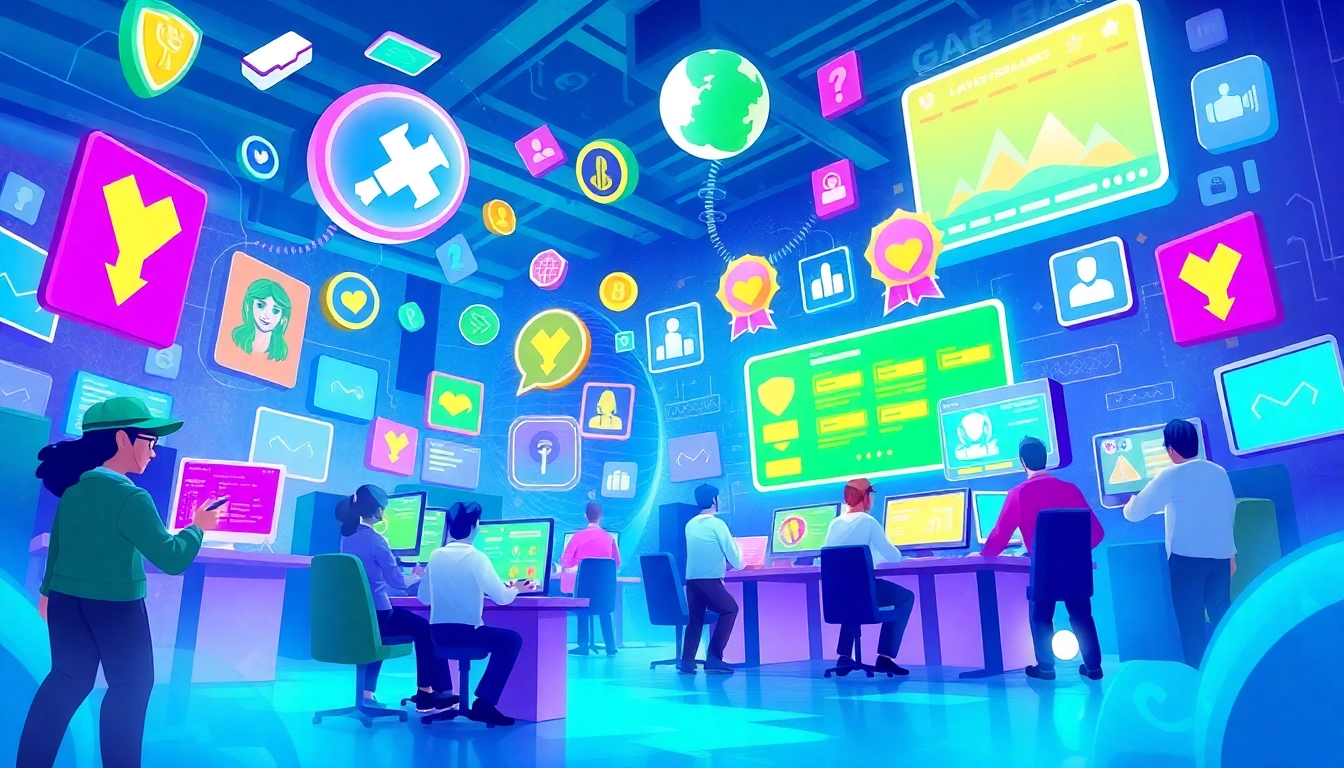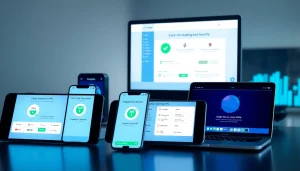Ultimate Gamification Tools for 2025: Boost Your Gaming Experience

Understanding Gamification Tools
What Are Gamification Tools?
Gamification tools are innovative platforms and technologies designed to incorporate game-like elements into various experiences, including educational and professional environments. These tools use aspects typically found in games, such as point scoring, leaderboards, and rewards, to engage users and drive participation. In the context of gaming, gamification tools enhance player involvement and retention, ultimately contributing to a more captivating game experience.
Benefits of Using Gamification Tools in Gaming
The benefits of gamification tools extend far beyond mere entertainment. They enable developers to:
- Increase Engagement: Players are more likely to stay engaged with games that offer rewards and challenges, as these elements stimulate continued interaction.
- Enhance Motivation: By integrating points, badges, and leaderboards, players feel a sense of achievement which can motivate them to progress further in the game.
- Foster Community: Many gamification tools promote social interaction, allowing players to compete or collaborate with each other, nurturing a sense of belonging.
- Boost Retention Rates: Games that utilize gamification effectively see improved player retention, as users develop habits around continued participation in the gaming experience.
- Gather Valuable Data: Gamification tools often include analytics that help developers understand player behavior, preferences, and engagement patterns, providing insights that drive future game development.
Common Features of Effective Gamification Tools
When selecting gamification tools, certain features stand out as crucial for effectiveness:
- User-Friendly Interface: A clear and intuitive interface enhances accessibility for both players and developers.
- Customization Options: The ability to tailor elements to fit the game’s theme is vital for seamless integration.
- Real-Time Feedback: Immediate responses to player actions increase satisfaction and encourage ongoing participation.
- Analytics and Reporting: Tools should provide comprehensive reports and insights into user engagement and behavior.
- Social Sharing Capabilities: Encouraging players to share achievements on social networks can amplify the game’s visibility and draw in new users.
Top Gamification Tools for Engaging Players
Review of Leading Gamification Platforms
Various platforms dominate the gamification landscape, each offering unique features and benefits. Here are a few top contenders:
- Badgeville: Known for its customizable rewards engine, Badgeville allows developers to create tailored gamification solutions that fit their specific user engagement needs.
- Bunchball: Offering robust analytics and a suite of gamification tools, Bunchball is popular among businesses and education sectors to drive employee engagement and learning.
- Gamify: A user-friendly platform that makes gamification accessible to all, Gamify allows users to build engaging content without extensive programming knowledge.
- Playlyfe: Focused on mobile application development, Playlyfe incorporates game mechanics that are effective for apps across various industries, especially in the gaming sector.
Comparative Analysis of Tools
When comparing gamification tools, developers should consider various factors such as ease of use, customization capabilities, as well as analytics features:
| Platform | Customization | Analytics | Price |
|---|---|---|---|
| Badgeville | High | Advanced | Custom pricing |
| Bunchball | Moderate | Comprehensive | Starting at $500/month |
| Gamify | High | Basic | $49/month |
| Playlyfe | Moderate | Intermediate | Free and paid options |
User Feedback and Ratings
User feedback is an invaluable resource for evaluating the effectiveness of gamification tools. Platforms like Badgeville typically receive high praise for their customization options, enabling developers to tailor experiences to meet the unique demands of their audience. Bunchball is often noted for its robust analytics, which help measure engagement effectively. In contrast, Gamify is frequently commended for its ease of use, although advanced users may find limitations in deeper analytics capabilities.
Implementing Gamification Tools in Your Games
Step-by-Step Guide to Integration
Integrating gamification tools into your game can be a straightforward process, following these steps:
- Define Objectives: Begin by outlining what you hope to achieve through gamification, such as increased player retention or enhanced user engagement.
- Select the Right Tool: Based on your objectives, choose a gamification tool that aligns with your needs and goals.
- Design Game Elements: Identify which features (points, badges, leaderboards) will best motivate your players.
- Integrate the Tool: Collaborate with developers to ensure a smooth incorporation of the gamification platform into your game’s architecture.
- Test and Optimize: Before full-scale implementation, run a beta version to gather feedback and optimize the user experience.
- Launch and Monitor: After launch, continually monitor player engagement and feedback to make data-driven adjustments.
Best Practices for Designing Gamified Experiences
Ensure the effectiveness of your gamified experiences by adhering to these best practices:
- Keep It Simple: Overly complex systems can deter engagement; simplicity enhances user experience.
- Offer Real Value: Rewards should be meaningful and relevant to players to cultivate continued interest and motivation.
- Foster Competition and Collaboration: Striking a balance between individual achievements and team collaboration can enhance community around the game.
- Be Adaptive: Create mechanisms for evolving game elements based on player feedback and analytics.
- Communicate Clearly: Ensure players understand how to earn rewards and progress; clarity improves user satisfaction.
Common Challenges and Solutions
While integrating gamification tools can yield tremendous benefits, challenges often arise:
- Challenge: Low adoption rates by players. Solution: Promote the benefits of gamification within the game, making players aware of the rewards and engagement improvements.
- Challenge: Overcomplicating mechanics. Solution: Keep game mechanics intuitive and user-friendly to prevent player frustration.
- Challenge: Sustainability of interest. Solution: Regularly refresh gamified elements to maintain player interest over time.
Case Studies on Successful Gamification in Gaming
Notable Games Using Gamification Tools
Many popular games effectively leverage gamification tools, significantly enhancing user experiences. Some notables include:
- Duolingo: This language-learning app incorporates gamification by rewarding users with points, levels, and achievements, making the learning process enjoyable.
- Fitocracy: Focused on fitness, Fitocracy allows users to earn points for workouts and compete on leaderboards, transforming fitness into a game.
- Call of Duty: The military shooter uses a leveling system where players earn experience points and unlock rewards, keeping motivation high among its vast player base.
Lessons Learned from Successful Implementation
Several lessons can be gleaned from these successful implementations:
- Empower Users: Providing players with meaningful choices leads to a more engaging experience.
- Incorporate Feedback Loops: Learning from user behavior allows developers to iterate and improve gamified systems over time.
- Identify Core User Motives: Understanding what drives user engagement can lead to better-targeted gamification strategies that resonate with players.
Future Trends in Gamification
Looking forward, several trends are predicted to shape the future of gamification in gaming:
- AI-Driven Personalization: Artificial intelligence will facilitate greater user personalization in gamification, catering experience to individual player preferences.
- Integration of Virtual and Augmented Reality: Combining gamification with VR and AR can enhance immersion and experiential learning.
- Cross-Platform Gamification: Players will increasingly expect a unified experience across various devices and platforms, driving the need for integrated gamification strategies.
Measuring the Impact of Gamification Tools
Key Performance Metrics to Track
To evaluate the success of gamification strategies, developers should track several key performance metrics:
- User Engagement: Measure how often and how long players engage with gamified elements.
- Completion Rates: Analyze whether players are completing challenges and tasks.
- Retention Rates: Monitor how many players return after their initial experience.
- Lifetime Value: Assess how gamification impacts the overall value of players over time.
Tools for Analytics and Feedback
Implementing effective analytics tools is critical for understanding player behavior:
- Google Analytics: Regularly analyze player engagement and website traffic.
- Mixpanel: Use event tracking to monitor user interactions with gamified elements.
- Hotjar: Evaluate how users interact with the game through heatmaps and session recordings, aiding in optimizing experiences.
Adjusting Strategies Based on Data Insights
Once metrics are gathered, adjusting strategies based on insights becomes vital. Effective methods include:
- A/B Testing: Test variations of gamified elements to identify which versions yield better engagement.
- Regular Feedback Surveys: Constantly collect player feedback to understand sentiments and improve offerings.
- Iterative Development: Continuously tweak and enhance gamified experiences based on data and feedback, ensuring they evolve to meet player expectations.






